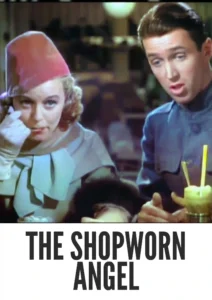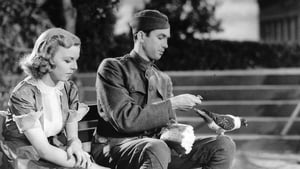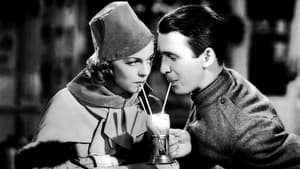Contact: [email protected]
Video Sources 0 Views
- Watch trailer
- The Shopworn Angel


Synopsis
Table of Contents
ToggleReview: The Shopworn Angel (1938) – A Heartfelt Romance Blossoms Amidst War

Introduction
“The Shopworn Angel” (1938) presents a poignant exploration of love and sacrifice against the backdrop of war. In this review, we’ll delve into the significance of this classic romance and its enduring charm that continues to captivate audiences.
Check The Full Colorized Movies List
Check Our Colorized Movies Trailer Channel
Understanding The Shopworn Angel 1938: Director, Cast, and Genre
Directed by H.C. Potter, “The Shopworn Angel” (1938) showcases his adeptness in weaving emotionally resonant narratives. The film stars Margaret Sullavan and James Stewart, whose on-screen chemistry brings to life the tender romance at the heart of the story. Set against the backdrop of World War I, “The Shopworn Angel” (1938) deftly blends elements of romance and drama, offering viewers a captivating glimpse into the lives of its compelling characters.
Exploring the World of The Shopworn Angel 1938: Plot and Characters
At its core, “The Shopworn Angel” (1938) follows the blossoming romance between a naive young woman, played by Margaret Sullavan, and a cynical soldier, portrayed by James Stewart. As their love deepens amidst the chaos of war, they are forced to confront the realities of life and the sacrifices required to preserve their newfound happiness. Along the way, they encounter a cast of memorable characters whose lives intersect in unexpected ways, adding depth and richness to the narrative.
The Art of Film Colorization
Film colorization serves as a transformative tool that enhances the visual experience of classic movies, breathing new life into timeless stories and captivating audiences with vibrant hues. By digitally adding color to black and white films, colorization allows viewers to immerse themselves in the rich tapestry of cinematic worlds, exploring every nuance and detail with fresh eyes and renewed appreciation.
Early Colored Films: A Brief History
The history of colored films traces its roots back to the early days of cinema, with filmmakers experimenting with various techniques to add color to their creations. From hand-tinted frames to early Technicolor processes, the evolution of colored film has been marked by innovation and ingenuity, paving the way for the development of modern colorization techniques that continue to captivate audiences to this day.
The Shopworn Angel 1938 and Its Early Colored Version
The decision to release “The Shopworn Angel” (1938) in a colorized format was met with both anticipation and trepidation. While some welcomed the opportunity to experience the film in vibrant color, others expressed concerns about the potential impact on its visual aesthetic. Nevertheless, the early colored version of “The Shopworn Angel” (1938) offers viewers a fresh perspective on the timeless romance, enhancing its emotional resonance and captivating audiences with its luminous beauty.
The Debate Over Film Colorization
The debate over film colorization continues to divide audiences and critics alike, with proponents praising its ability to breathe new life into classic movies and introduce them to a new generation of viewers, while detractors argue that it compromises the artistic integrity of the original work and diminishes its historical significance. As the debate rages on, filmmakers and audiences alike are left to ponder the merits and drawbacks of colorization in the ever-evolving landscape of cinema.
Examining The Shopworn Angel 1938 as an Early Colored Film
As with any colorized classic, the impact of colorization on “The Shopworn Angel” (1938) is a matter of personal interpretation. Some may argue that it enhances the film’s visual appeal and immerses viewers in its world, while others may feel that it detracts from the stark beauty of the original black and white version. Regardless of one’s stance on the issue, there’s no denying the enduring power of “The Shopworn Angel” (1938) as a timeless romance that continues to capture the hearts of audiences around the world.
Influence and Legacy: The Shopworn Angel 1938’s Impact on Cinema
“The Shopworn Angel” (1938) has left an indelible mark on the world of cinema, inspiring countless filmmakers and captivating audiences with its timeless tale of love and sacrifice. From its unforgettable performances to its sweeping cinematography, the film continues to resonate with viewers of all ages, reaffirming its status as a beloved classic of the romance genre.
Director’s Cinematic Legacy: Beyond The Shopworn Angel 1938
H.C. Potter’s influence extends far beyond “The Shopworn Angel” (1938), with a diverse body of work that continues to captivate audiences around the globe. From “Mr. Lucky” to “The Farmer’s Daughter,” Potter’s films are celebrated for their emotional depth, compelling characters, and poignant storytelling, solidifying his legacy as one of the preeminent directors of Hollywood’s Golden Age. Through his groundbreaking work, Potter has left an indelible imprint on the world of cinema, inspiring generations of filmmakers to follow in his footsteps.
Themes Explored in The Shopworn Angel 1938
“The Shopworn Angel” (1938) explores a myriad of themes, from the transformative power of love to the resilience of the human spirit in the face of adversity. Through its richly drawn characters and poignant storytelling, the film invites viewers to ponder the complexities of the human heart and the enduring strength of the human spirit. As audiences immerse themselves in the world of “The Shopworn Angel” (1938), they are reminded of the universal truths that bind us together and the enduring power of love to overcome even the greatest of obstacles.
Reception and Controversy Surrounding The Shopworn Angel 1938
Upon its release, “The Shopworn Angel” (1938) received widespread critical acclaim, with many praising its heartfelt performances, tender romance, and timeless themes. However, the decision to release the film in a colorized format sparked debate among purists, reigniting the age-old discussion surrounding film preservation and artistic integrity. Despite the controversy, “The Shopworn Angel” (1938) remains a beloved classic that continues to resonate with audiences of all ages, reaffirming its status as a timeless masterpiece of the romance genre.
Where to Watch The Shopworn Angel 1938 Online
For those eager to experience the timeless magic of “The Shopworn Angel” (1938), the film is readily available on popular streaming platforms such as Netflix, Amazon Prime, and Hulu. Whether you choose to watch it in its original black and white format or the early colored version, “The Shopworn Angel” (1938) promises to transport you to a world of romance and sacrifice, where love knows no bounds and the human spirit shines brightest in the darkest of times.
FAQs About The Shopworn Angel 1938
Q: Is “The Shopworn Angel” (1938) based on a true story? A: No, “The Shopworn Angel” (1938) is a fictional tale crafted by screenwriter Waldo Salt, inspired by the lives of soldiers and their loved ones during World War I.
Q: Who are the main actors in “The Shopworn Angel” (1938)? A: “The Shopworn Angel” (1938) features an ensemble cast led by Margaret Sullavan and James Stewart, whose poignant performances breathe life into the film’s tender romance.
Q: What awards did “The Shopworn Angel” (1938) win? A: While “The Shopworn Angel” (1938) did not win any major awards, it received critical acclaim for its heartfelt performances and timeless storytelling.
Q: Why was “The Shopworn Angel” (1938) released in a colorized format? A: The decision to release “The Shopworn Angel” (1938) in color was made to introduce the film to a new generation of viewers and enhance its visual appeal for modern audiences. While the choice to colorize the film sparked debate among purists, it ultimately allowed “The Shopworn Angel” (1938) to reach a wider audience and ensure its continued relevance in the annals of cinematic history.
Conclusion
“The Shopworn Angel” (1938) remains a timeless classic that continues to captivate audiences with its heartfelt romance and poignant storytelling. Whether viewed in its original black and white format or the early colored version, the film serves as a poignant reminder of the enduring power of love and sacrifice in the face of adversity. As we journey through the trials and triumphs of its compelling characters, we are reminded of the universal truths that bind us together as human beings, and the enduring strength of the human spirit to overcome even the greatest of obstacles. So, whether you’re a seasoned cinephile or a casual moviegoer, take a moment to experience the magic of “The Shopworn Angel” (1938) and discover for yourself why it continues to resonate with audiences of all ages.












